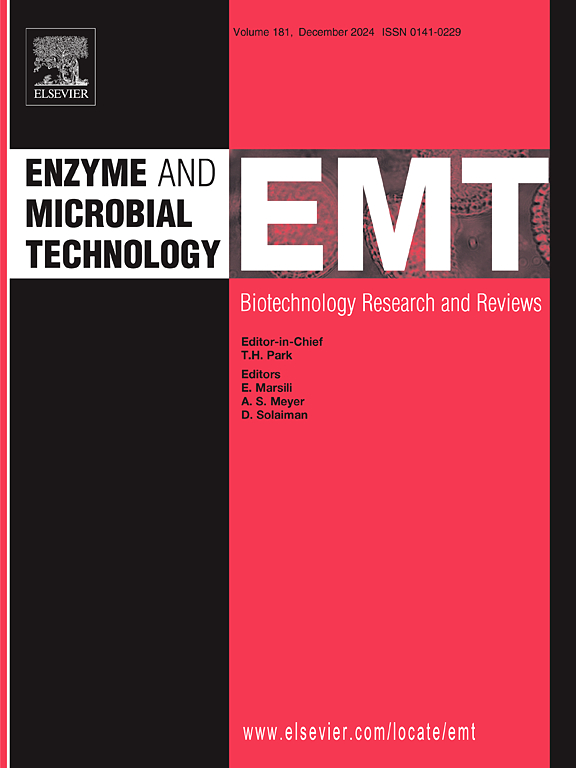在分子动力学模拟的辅助下,从loti中分离出一种最小的可溶碳酸酐酶
IF 3.7
3区 生物学
Q2 BIOTECHNOLOGY & APPLIED MICROBIOLOGY
引用次数: 0
摘要
碳酸酐酶(carbon anhydrase, CAs)具有将二氧化碳转化为碳酸氢盐的显著效率,是碳捕获和利用中的关键生物催化剂。其中,loti中根瘤菌(MlCA)的CA表现出最高的催化活性。但其在大肠杆菌中的低表达和低溶解度严重限制了其应用。为了克服这些挑战,我们采用了蛋白质最小化策略来提高酶的表达和溶解性。在具有短n端标签的遗传结构中,MlCA的表达受到起始密码子附近mRNA二级结构的强烈影响。针对溶解度问题,建立了以分子动力学模拟为指导的蛋白质从头设计流程。该过程包括四个阶段:(1)使用AlphaFold和RFdiffusion考虑尺寸约束的从头设计,(2)依靠solubleMPNN和ESMfold进行序列恢复,(3)通过FoldX, SASA和分子动力学评估进行硅筛选,(4)实验验证。这使得在500个候选基因中产生紧凑、稳定和催化活性的MlCA变异,其蛋白质大小减少了28% %。最后,最有希望的设计dM22,最小CA的设计在GroELS整合BL21(DE3)菌株B7G中的溶解度从16.1 %提高到61.2 %。本文章由计算机程序翻译,如有差异,请以英文原文为准。
De Novo enzyme design of a minimal and soluble carbonic anhydrase from Mesorhizobium loti assisted by molecular dynamics simulation
Carbonic anhydrases (CAs) are critical biocatalysts in the carbon capture and utilization due to their remarkable efficiency in converting carbon dioxide into bicarbonate. Among all, the CA from Mesorhizobium loti (MlCA) exhibits the highest catalytic activity. However, the poor expression and low solubility in Escherichia coli significantly restricts its application. To overcome the challenges, we employed a protein minimization strategy to improve both enzymatic expression and solubility. Enhanced expressions were observed in genetic constructs with short N-terminal tags which MlCA expression is strongly affected by mRNA secondary structure near the start codon. For solubility issue, a de novo protein design workflow guided by molecular dynamics simulations was developed. The process consists of four stages: (1) size-constrained de novo design considered using AlphaFold and RFdiffusion, (2) sequence recovery replying on solubleMPNN and ESMfold, (3) In silico screening by FoldX, SASA and molecular dynamics evaluation, and (4) experimental validation. This enabled the generation of compact, stable, and catalytically active MlCA variants with 28 % reduction in protein size among 500 candidates. Finally, the most promising design, dM22, of minimal CA showed improved solubility from 16.1 % to 61.2 % in B7G, a GroELS integrated BL21(DE3) strain.
求助全文
通过发布文献求助,成功后即可免费获取论文全文。
去求助
来源期刊

Enzyme and Microbial Technology
生物-生物工程与应用微生物
CiteScore
7.60
自引率
5.90%
发文量
142
审稿时长
38 days
期刊介绍:
Enzyme and Microbial Technology is an international, peer-reviewed journal publishing original research and reviews, of biotechnological significance and novelty, on basic and applied aspects of the science and technology of processes involving the use of enzymes, micro-organisms, animal cells and plant cells.
We especially encourage submissions on:
Biocatalysis and the use of Directed Evolution in Synthetic Biology and Biotechnology
Biotechnological Production of New Bioactive Molecules, Biomaterials, Biopharmaceuticals, and Biofuels
New Imaging Techniques and Biosensors, especially as applicable to Healthcare and Systems Biology
New Biotechnological Approaches in Genomics, Proteomics and Metabolomics
Metabolic Engineering, Biomolecular Engineering and Nanobiotechnology
Manuscripts which report isolation, purification, immobilization or utilization of organisms or enzymes which are already well-described in the literature are not suitable for publication in EMT, unless their primary purpose is to report significant new findings or approaches which are of broad biotechnological importance. Similarly, manuscripts which report optimization studies on well-established processes are inappropriate. EMT does not accept papers dealing with mathematical modeling unless they report significant, new experimental data.
 求助内容:
求助内容: 应助结果提醒方式:
应助结果提醒方式:


